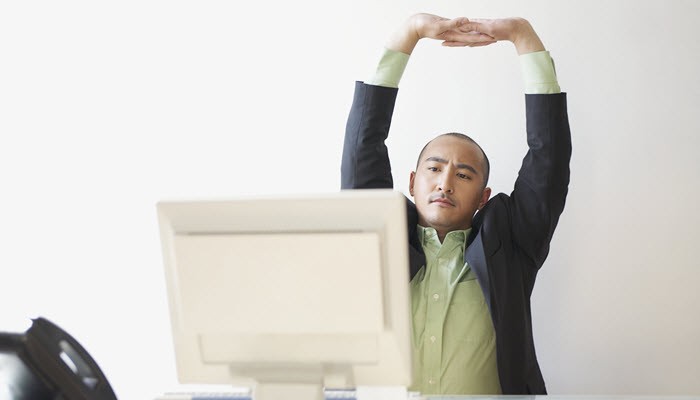Work Out at Work!
Easy ways to get energized on the job.

Do you spend a good portion of your work days sitting — in a car or bus, at your desk, during lunch, in meetings? If so, you may struggle to fit in enough physical activity during the week. But have you ever thought about working out at work? With some creativity and effort, there are ways you can squeeze in some activity during your work day — and benefit from every step you take!
Why move more?
Bodies are made for motion. Exercise recommendations for most adults include at least 150 minutes of moderate-intensity aerobic activity and two days or more of strength training each week.* But adding general activity over the course of the day helps, too. Plus, staying active can help you lose weight, improve your mood, boost your heart health and reduce your risk of developing type 2 diabetes.
Why sit less?
Too much sitting — or being sedentary in general — may significantly increase your risk for heart disease and diabetes. It can also increase your risk for becoming overweight or obese. Yet many of us spend a good portion of the day at our desks. In fact, sedentary jobs make up more than 80 percent of our workforce today.
Tips to try during the workday
Here are some fast and easy ways to move more — and help keep your mind and body energized during the workday. Try to stand or walk for a bit around every 30 minutes or so. And remember that even 10 minutes of moderate aerobic activity at a time has health benefits. Just be sure to check with your manager about what your office culture will allow or not allow.
Around the office
Be more active in your office.*
- Get outside. Take a walk during your coffee break or over lunch. And invite a friend!
- Take the stairs. Use the stairs instead of the elevator whenever you can.
- Walk and talk. Do you use a cell phone for work calls? Get up and walk while you’re talking.
- Skip in-office emails. Walk down the hall and visit your coworker instead.
- Walk after lunch. Go for a leisurely walk with your coworkers after you finish your meal.
At your desk
Take 10 minutes every so often during your day to fit in short workouts at your desk — if your office culture allows it. You just need your chair and a wall to do a number of flexibility, balance and strength exercises.
For flexibility: Stretch out your ankles, calves and thighs. And if you’ve been hunching over your computer, be sure to stretch your neck, back, chest and upper body.
For balance: Walk heel to toe, or stand on one foot.
For strength:
- Try a wall push-up to work your upper body. Just make sure the activity doesn’t disturb your colleagues. Facing a wall, feet shoulder-width apart, stand a bit farther than an arm’s length away. Lean your body forward. Put your palms flat against the wall at shoulder height and slowly bend your elbows, lowering your upper body toward the wall. Keep feet flat on the floor. Hold for one second, then push back until arms are straight. That’s one.
- Try a chair stand for lower-body strength. Sitting toward the front of a sturdy chair, keep knees bent, feet flat on the floor. Bring your upper body forward until you’re sitting upright. Extend your arms so they are parallel to the floor. Slowly stand up. Then, slowly sit down. That’s one.
The more active you are, the more benefits you’ll reap. Take it one step at a time and keep up the great work!
*If you’re pregnant, have been physically inactive or have a health condition such as arthritis, diabetes or heart disease, check with your doctor before starting an exercise program or increasing your activity level. He or she can tell you what types and amounts of activities are safe for you.
By Lucy M. Casale, Contributing Writer
Sources
U.S. Department of Health and Human Services. 2008 physical activity guidelines for Americans. Chapter 2: Physical activity has many health benefits. Accessed September, 2017.
National Heart, Lung, and Blood Institute. What causes overweight and obesity? Accessed September 30, 2017.
National Institute on Aging: Go4Life. Work out at work (PDF). Accessed September 30, 2017.
American College of Sports Medicine. Reducing sedentary behaviors: Sitting less and moving more. Accessed September 30, 2017.
Updated November 5, 2017
